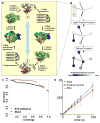Protein function prediction: towards integration of similarity metrics
- PMID: 21353529
- PMCID: PMC3120633
- DOI: 10.1016/j.sbi.2011.02.001
Protein function prediction: towards integration of similarity metrics
Abstract
Genomic centers discover increasingly many protein sequences and structures, but not necessarily their full biological functions. Thus, currently, less than one percent of proteins have experimentally verified biochemical activities. To fill this gap, function prediction algorithms apply metrics of similarity between proteins on the premise that those sufficiently alike in sequence, or structure, will perform identical functions. Although high sensitivity is elusive, network analyses that integrate these metrics together hold the promise of rapid gains in function prediction specificity.
Copyright © 2011 Elsevier Ltd. All rights reserved.
Figures


References
-
- Rost B. Enzyme function less conserved than anticipated. J Mol Biol. 2002;318:595–608. - PubMed
Publication types
MeSH terms
Substances
Grants and funding
LinkOut - more resources
Full Text Sources
Miscellaneous

